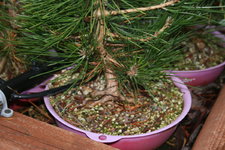JackHammer
Chumono
My understanding is that a colander can be used for pine trees in an effort to make the roots compact and fiberous enough for placement in a bonsai pot. Any roots that are near the surface of the colander will dry out and die back creating a dense root ball.
Doesn't terra cotta do a very similar thing? As long as the pot isn't soaking in a drip tray, the outside roots are generally dissuaded from growing too long due to the drying nature of terra cotta. I am under the assumption that the sun and wind on any given day would remove a significant amount of water from the sides of the pot, keeping the roots in a more compact fashion. Is this correct?
I am asking because the colander concept while valid, seems quite volitile. Even slowing the process slightly and working to capture similar results would likely allow for a less intense and more forgiving maintenance schedule. Is the trade off worth It?
Doesn't terra cotta do a very similar thing? As long as the pot isn't soaking in a drip tray, the outside roots are generally dissuaded from growing too long due to the drying nature of terra cotta. I am under the assumption that the sun and wind on any given day would remove a significant amount of water from the sides of the pot, keeping the roots in a more compact fashion. Is this correct?
I am asking because the colander concept while valid, seems quite volitile. Even slowing the process slightly and working to capture similar results would likely allow for a less intense and more forgiving maintenance schedule. Is the trade off worth It?











